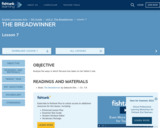
Analyze the ways in which Parvana has taken on her father's role.
- Subject:
- English Language Arts
- Reading Literature
- Material Type:
- Homework/Assignment
- Lesson Plan
- Author:
- Fishtank Learning
- Date Added:
- 05/22/2021

Analyze the ways in which Parvana has taken on her father's role.
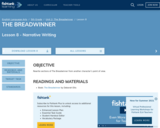
Rewrite sections of The Breadwinner from another character’s point of view.
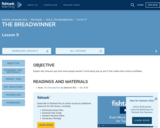
Explain why Shauzia says that some people wouldn’t mind being dug up and if that makes their actions justifiable.

Tony Sarg was a puppeteer and marionette master who invented the first, larger than life, helium balloons for the annual Macy’s Thanksgiving Day Parade. The resource includes a lesson plan/book card, a design challenge, and copy of a design thinking journal that provide guidance on using the book to inspire students' curiosity for design thinking. Maker Challenges include: (1) Dash/Sphero: Develop a Macy’s Day Parade route using tape on the ground with a partner. Then, switch routes with another group and program the robot of your choice to navigate the parade route using code. (2) Ozobot: Develop a synchronized dance routine for both Ozobots for the stage of the Macy’s day parade using https://ozoblockly.com/editor (3) Create a moveable puppet that will be featured in the Macy’s Day Parade.
A document is included in the resources folder that lists the complete standards-alignment for this book activity.

Learn what banned books are and about the history of banned, burned and challenged books. See classic books that have been banned that are available in COM Library, and download free banned classics.

An Shakespearean Introduction to Computational Thinking
Project Guide
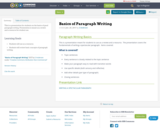
This is a presentation for students on the basics of good paragraph writing. Presentation is meant as a review and a resource for student use.
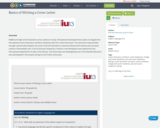
Students learn how to write a basic cover letter.
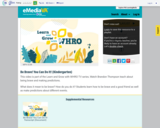
This video is part of the Learn and Grow with WHRO TV series. Watch Brandon Thompson teach about being brave and making predictions.
What does it mean to be brave? How do you do it? Students learn how to be brave and a good friend as well as make predictions about different events.
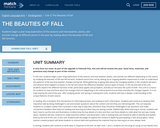
In this unit, students begin a year-long exploration of the seasons and how weather, plants, and animals are different depending on the season by studying the beauties of fall and fall harvests. Students launch the unit by setting up an ongoing weather experiment in order to understand the patterns of fall and how weather changes during fall. While gathering on-going data about the changing weather in fall, students will learn and observe what happens to leaves in the fall and notice the difference between various types of leaves. In the second half of the unit, students explore the different harvests of fall, particularly apples and pumpkins, and discuss the basic life cycles of both. This unit is a chance for students to stop and think about the changes that are happening in the natural world around them and why the changes happen. It is our hope that by the end of the year, after studying winter and spring in subsequent units, students will have a deeper understanding of the unique features of each season.
In reading, this is students’ first introduction to informational texts and reading to learn information. Students will continue to develop their inquisitive side by being challenged to ask and answer questions about the content and text they are interacting with. This unit exposes students to a subject matter that is present in their day-to-day lives; therefore, they should be challenged to ask questions and make connections between what they are reading and learning and what they are seeing outside. Additionally, while listening to stories, students will learn how to use the text and illustrations to determine the key details of a text and then use those details to retell what the text was mostly about. Students will also continue to understand the author’s and illustrator’s roles in writing texts and should be able to identify and explain both by the end of the unit. In this unit, students will also begin to explore the content in-depth by participating in labs and projects. These teacher-created projects will allow students to interact with and synthesize the material they are learning at an even deeper level.
In writing, students will continue to write daily in response to the text. As with units 1 and 2, students are focusing on using correct details from the text to answer the question. Students should be using a combination of words and pictures, depending on the student’s development as a writer. Daily teaching points, based on student data, should be included to ensure that students are progressing as writers.

In this unit, students begin a year-long exploration of the seasons and how weather, plants, and animals are different depending on the season by studying the beauties of fall and fall harvests. Students launch the unit by setting up an ongoing weather experiment in order to understand the patterns of fall and how weather changes during fall. While gathering on-going data about the changing weather in fall, students will learn and observe what happens to leaves in the fall and notice the difference between various types of leaves. In the second half of the unit, students explore the different harvests of fall, particularly apples and pumpkins, and discuss the basic life cycles of both. This unit is a chance for students to stop and think about the changes that are happening in the natural world around them and why the changes happen. It is our hope that by the end of the year, after studying winter and spring in subsequent units, students will have a deeper understanding of the unique features of each season. In reading, this is students' first introduction to informational texts and reading to learn information. Students will continue to develop their inquisitive side by being challenged to ask and answer questions about the content and text they are interacting with. This unit exposes students to a subject matter that is present in their day-to-day lives; therefore, they should be challenged to ask questions and make connections between what they are reading and learning and what they are seeing outside. Additionally, while listening to stories, students will learn how to use the text and illustrations to determine the key details of a text and then use those details to retell what the text was mostly about. Students will also continue to understand the author's and illustrator's roles in writing texts and should be able to identify and explain both by the end of the unit. In this unit, students will also begin to explore the content in-depth by participating in labs and projects. These teacher-created projects will allow students to interact with and synthesize the material they are learning at an even deeper level. In writing, students will continue to write daily in response to the text. As with units 1 and 2, students are focusing on using correct details from the text to answer the question. Students should be using a combination of words and pictures, depending on the student's development as a writer. Daily teaching points, based on student data, should be included to ensure that students are progressing as writers.
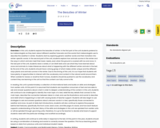
In this unit, students explore the beauties of winter. In the first part of the unit students pretend to be meteorologists as they learn about different weather forecasts and the words that meteorologists use to describe the weather in winter. Students start by exploring generic weather words and then transition into winter-specific words. In the second part of the unit, students explore how animals survive in the winter and the ways in which animals meet their basic needs, even when the ground is covered with ice and snow. In the last part of the unit, students read a variety of Jan Brett texts and use what they have learned about snow and animals to make inferences about what is happening with the different winter animals in the text. By the end of the unit, students should have a strong grasp of what makes winter unique and the different ways plants and animals survive in the winter. Due to the timing of this unit, it is our hope that students will have plenty of opportunities to interact with the vocabulary and content in the natural world around them. When outside for recess or anytime that it snows, students should be pushed to use the vocabulary and content they are learning in the unit so that the content can fully come to life. In reading, this unit is predominately a collection of informational texts and builds on skills and strategies from earlier units. At this point it is assumed that students are inquisitive consumers of text and are able to ask and answer questions about a text in order to deepen understanding of the content. In this unit, students will continue to be challenged to identify the main topic of a text, retell the key details that connect to the main topic, describe the connection between ideas in a text, and use the illustrations and words to describe and retell what is happening in a text with varying levels of teacher support. Students will also begin to use strategies to ask and answer questions about unknown words in a text, specifically those connected to weather and snow. As part of daily text introductions, students will also continue to explore the purpose behind text features, specifically the front cover, back cover, and title page of a book, and how each feature supports understanding of the text. Many of the skills and strategies in this unit are spiraled from earlier units or will be spiraled through upcoming units; therefore, it is up to the teacher to decide what level of support students need with the particular strategy and scaffold accordingly. In writing, students will continue to write daily in response to the text. At this point in the year, students should be using a combination of drawing and words to correctly answer the question. Pick focus teaching points based on data from previous units and individual student needs.
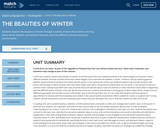
In this unit, students explore the beauties of winter. In the first part of the unit students pretend to be meteorologists as they learn about different weather forecasts and the words that meteorologists use to describe the weather in winter. Students start by exploring generic weather words and then transition into winter-specific words. In the second part of the unit, students explore how animals survive in the winter and the ways in which animals meet their basic needs, even when the ground is covered with ice and snow. In the last part of the unit, students read a variety of Jan Brett texts and use what they have learned about snow and animals to make inferences about what is happening with the different winter animals in the text. By the end of the unit, students should have a strong grasp of what makes winter unique and the different ways plants and animals survive in the winter. Due to the timing of this unit, it is our hope that students will have plenty of opportunities to interact with the vocabulary and content in the natural world around them. When outside for recess or anytime that it snows, students should be pushed to use the vocabulary and content they are learning in the unit so that the content can fully come to life.
In reading, this unit is predominately a collection of informational texts and builds on skills and strategies from earlier units. At this point it is assumed that students are inquisitive consumers of text and are able to ask and answer questions about a text in order to deepen understanding of the content. In this unit, students will continue to be challenged to identify the main topic of a text, retell the key details that connect to the main topic, describe the connection between ideas in a text, and use the illustrations and words to describe and retell what is happening in a text with varying levels of teacher support. Students will also begin to use strategies to ask and answer questions about unknown words in a text, specifically those connected to weather and snow. As part of daily text introductions, students will also continue to explore the purpose behind text features, specifically the front cover, back cover, and title page of a book, and how each feature supports understanding of the text. Many of the skills and strategies in this unit are spiraled from earlier units or will be spiraled through upcoming units; therefore, it is up to the teacher to decide what level of support students need with the particular strategy and scaffold accordingly.
In writing, students will continue to write daily in response to the text. At this point in the year, students should be using a combination of drawing and words to correctly answer the question. Pick focus teaching points based on data from previous units and individual student needs.

The true, inspiring story of Beauty, the bald eagle, who was shot, rescued, and received a 3D-printed prosthetic beak. The resource includes a lesson plan/book card, a design challenge, and copy of a design thinking journal that provide guidance on using the book to inspire students' curiosity for design thinking. Maker Challenges: (1) Use paper and pencil to design a prosthetic body part for a human or animal. Then use tinkercad.com to create a prototype. Finally, use a 3D printer to print the prosthetic. (2) Have students research animals who use prosthetics. Then, improve the design in Tinkercad and 3D Print.
A document is included in the resources folder that lists the complete standards-alignment for this book activity.
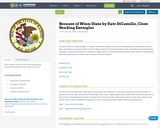
This outlines the 2-day close reading exemplar developed by Student Achievement Partners.
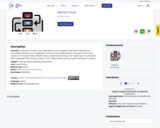
In this lesson, students use the Bee Bots to move throughout their space. If Bee Bots are inaccessible, the lesson can be adapted by using the online coding platform. This lesson is part of the Virginia K-12 Computer Science Pipeline which is partly funded through a GO Virginia grant in partnership with Chesapeake Public Schools, Loudoun County Public Schools, and the Loudoun Education Foundation.

In this lesson, students use the Bee Bots to move throughout their space. If Bee Bots are inaccessible, the lesson can be adapted by using the online coding platform.
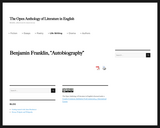
The life of Dr. Benjamin Franklin, written by himself. Second American Edition.
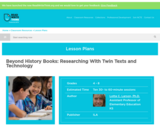
Students in Grades 4-8 activate prior knowledge and research information about a historic event through fiction and nonfiction literature and exploration of relevant websites.

Beyond Penguins and Polar Bears is an online professional development magazine which focuses on preparing elementary teachers to teach polar science concepts while also integrating inquiry-based science and literacy instruction. The project draws on research showing that an integrated approach can improve student achievement in science, as well as in reading comprehension and oral and written discourse abilities. Ultimately, the project seeks to bring the polar regions “closer to home” for elementary teachers and their students.